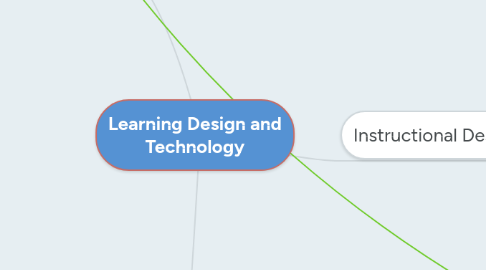
1. Learning Theories
1.1. Behaviorism
1.1.1. Key parameters
1.1.1.1. Learning is a relatively permanent change in observable behavior (Jonassen, 2003)
1.1.1.2. Mind as a Black Box
1.1.1.3. Classical conditioning: Stimulus and Response
1.1.1.4. Operant conditioning : based on voluntary behavior, involves positive or negative reinforcement
1.1.1.5. Mind processes not important
1.1.1.6. Focus on observable cause and effect relationship
1.1.1.7. Student remember and respond
1.1.1.8. Teachers present and provide practice and feedback
1.1.2. Instructional Implications
1.1.2.1. Teacher
1.1.2.1.1. Dispenser of reward or punishment
1.1.2.2. Student
1.1.2.2.1. Recipient of reward or punishment
1.1.3. Key persons
1.1.3.1. Edward Thorndike
1.1.3.1.1. Thorndike’s puzzle boxes
1.1.3.2. B. F. Skinner
1.1.3.2.1. Operant Conditioning Chamber
1.1.3.3. Clark Hull
1.1.3.3.1. Drive reduction theory of motivation
1.1.4. Examples
1.1.4.1. Reward system for primary school students
1.1.4.2. Behavior Therapy for behavior management
1.2. Cognitivism
1.2.1. Key parameters
1.2.1.1. Learning as information transmission & processing
1.2.1.2. Learning viewed as the acquisition of new information
1.2.1.3. Mind as an information processor
1.2.1.4. Short term, long-term and working memory
1.2.1.4.1. overcoming short term memory limitation
1.2.1.4.2. Attention - Essential for moving information from the sensory memory to the working memory
1.2.1.5. Thinking involves manipulation of representations
1.2.1.6. Transfer of knowledge through cognitive strategies
1.2.1.7. Students remember rules, patterns and strategies
1.2.2. Instructional Implications
1.2.2.1. Instructor
1.2.2.1.1. Information dispenser, transmitter
1.2.2.1.2. Gain learners’ attention
1.2.2.1.3. Relate from earlier experiences.
1.2.2.1.4. Recognize limitations of the working memory
1.2.2.2. Student
1.2.2.2.1. Information receiver, processor
1.2.3. Key persons
1.2.3.1. Atkinson, R.C., Shiffrin, R.M.
1.2.3.1.1. Cognitive Information Processing Model
1.2.3.2. Lachman, Lachman and Butterfield
1.2.3.2.1. Cognitive psychology
1.2.3.3. Jean Piaget
1.2.3.3.1. Cognitive Development Theory
1.2.3.4. Lev Vygotsky
1.2.3.4.1. Zone of proximal development
1.3. Constructivism
1.3.1. Key parmeters
1.3.1.1. Humans learn by constructing their own representations/models of experiences
1.3.1.2. Knowledge is inseparable from knower
1.3.1.3. Learning is active process that involves personal discoveries
1.3.1.4. Social constructivism evolved from cognitive constructivism
1.3.2. Instructional Implications
1.3.2.1. Teacher
1.3.2.1.1. guide, facilitator of academic tasks
1.3.2.2. Student
1.3.2.2.1. sense maker, knowledge constructor
1.3.3. Key persons
1.3.3.1. Jean Piaget
1.3.3.1.1. Understanding to be reconstructed by rediscovery
1.3.3.2. Lev Vygotsky
1.3.3.2.1. Scaffolding for individual Zone of proximal development
1.3.3.3. Steffe and Gale
1.3.3.3.1. Six core paradigm of constructivism
1.3.4. Ideas and Reflection
1.4. Ideas and Reflection
2. Technology
2.1. Web 2.0 Technologies
2.1.1. Readings
2.1.1.1. Hew, K. F., & Cheung, W. S. (2013). Use of web 2.0 technologies in K-12 and higher education: the search for evidence-based practice. Educational Research Review,
2.1.1.1.1. allows individuals to collaborate with one another and contribute to the authorship of content, customize web sites for their use, and instantaneously publish their thoughts (Alexander, 2006; Heafner & Friedman, 2008)
2.1.1.1.2. Blog
2.1.1.1.3. Wiki
2.1.1.1.4. Voicethread
2.1.1.1.5. Twitter
2.1.1.1.6. Facebook
2.1.1.1.7. Second Life
2.1.1.1.8. Delicious
2.1.1.1.9. Youtube
2.1.1.1.10. Podcast
2.2. Ideas and Reflections
2.3. Impact on Blended Learning
2.3.1. Integration of online and face-to-face strategies
3. Instructional Design
3.1. Definition
3.1.1. A system of procedures for developing education and training programs in a consistent and reliable fashion.
3.2. History
3.2.1. The Origins of Instructional Design, World War II
3.3. Instruction Design Model
3.3.1. ADDIE Process
3.3.1.1. Analyze
3.3.1.1.1. Needs Assessment
3.3.1.1.2. Cause
3.3.1.1.3. Focus of Needs
3.3.1.1.4. Task Analysis
3.3.1.1.5. Learner Analysis
3.3.1.1.6. Ideas and Reflection
3.3.1.2. Design
3.3.1.2.1. Learning Objective
3.3.1.2.2. Motivation
3.3.1.2.3. Robert Gagné’s Nine Events of Instruction
3.3.1.3. Development
3.3.1.3.1. Develop of Instruction Materials
3.3.1.3.2. Testing of Instruction Materials
3.3.1.3.3. Resources
3.3.1.4. Implement
3.3.1.4.1. Develops procedures for training facilitators and learners
3.3.1.4.2. Conduct pilot run
3.3.1.4.3. Resources
3.3.1.5. Evaluate
3.3.1.5.1. Four Levels of Learning Evaluation by Kirkpatrick
3.3.1.5.2. The final phase, Evaluate, ensures the materials achieved the desired goals
3.3.1.5.3. Ideas and Reflections
3.3.1.5.4. Reading
